Radio Pulsar Binary Proves Einstein at Least 99.99% Right

Researchers have conducted a 16-year long experiment to challenge Einstein’s theory of general relativity. The international team looked to the stars – a pair of extreme stars called pulsars to be precise – through seven radio telescopes across the globe. Credit: Max Planck Institute for Radio Astronomy
More than a hundred years have passed since Einstein formalized his theory of General Relativity (GR), the geometric theory of gravitation that revolutionized our understanding of the Universe. And yet, astronomers are still subjecting it to rigorous tests, hoping to find deviations from this established theory. The reason is simple: any indication of physics beyond GR would open new windows onto the Universe and help resolve some of the deepest mysteries about the cosmos.
One of the most rigorous tests ever was recently conducted by an international team of astronomers led by Michael Kramer of the Max Planck Institute for Radio Astronomy (MPIfR) in Bonn, Germany. Using seven radio telescopes from across the world, Kramer and his colleagues observed a unique pair of pulsars for 16 years. In the process, they observed effects predicted by GR for the first time, and with an 
Pulsars are fast-spinning neutron stars that emit narrow, sweeping beams of radio waves. Credit: NASA’s Goddard Space Flight Center
“Radio pulsars” are a special class of rapidly rotating, highly magnetized neutron stars. These super-dense objects emit powerful radio beams from their poles that (when combined with their rapid rotation) create a strobing effect that resembles a lighthouse. Astronomers are fascinated by pulsars because they provide a wealth of information on the physics governing ultra-compact objects, magnetic fields, the interstellar medium (ISM), planetary physics, and even cosmology.
In addition, the extreme gravitational forces involved allow astronomers to test predictions made by gravitational theories like GR and Modified Newtonian Dynamics (MOND) under some of the most extreme conditions imaginable. For the sake of their study, Kramer and his team examined PSR J0737-3039 A/B, the “Double Pulsar” system located 2,400 light-years from Earth in the constellation Puppis.
This system is the only radio Radio Pulsar Binary Proves Einstein at Least 99.99% Right
